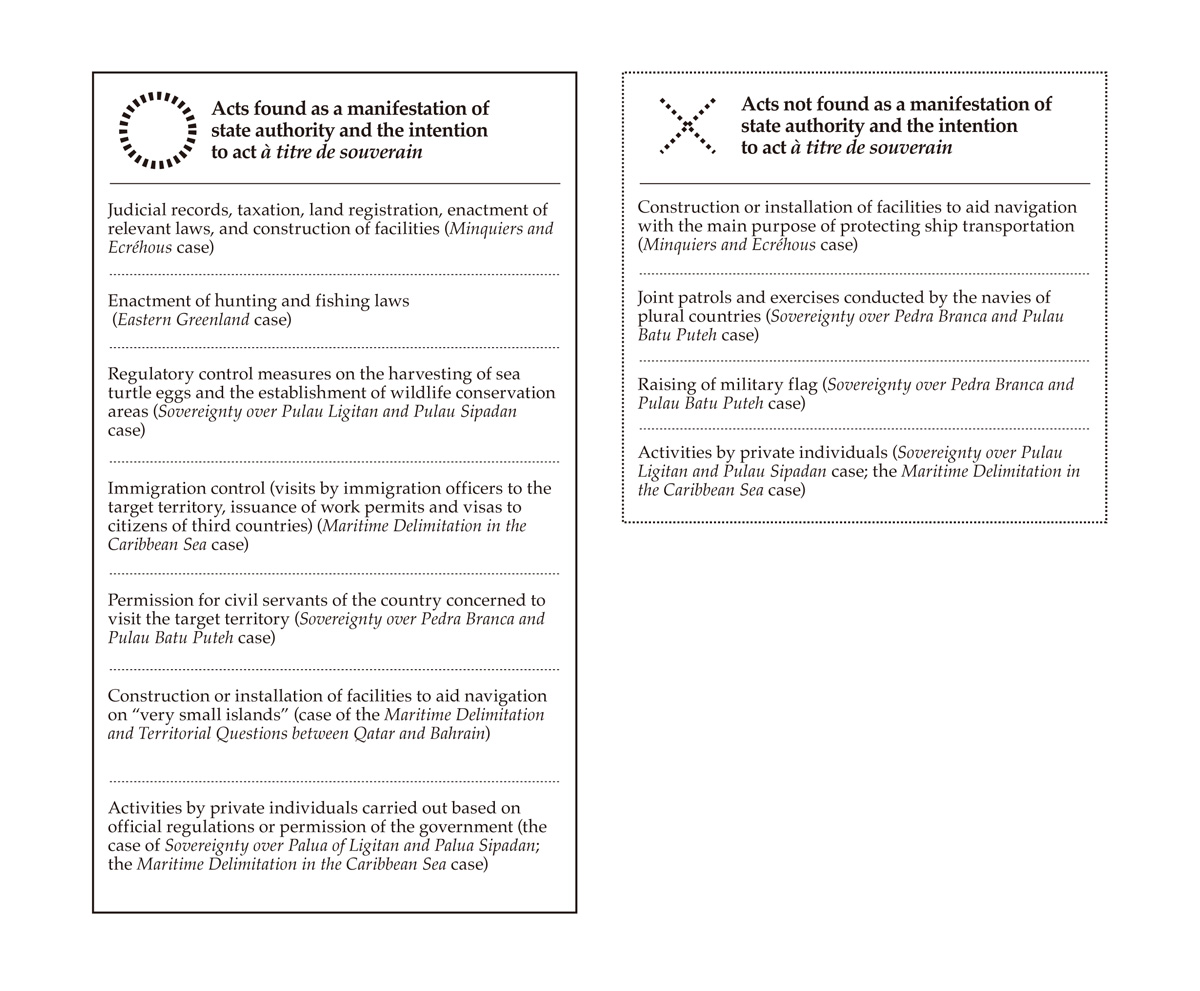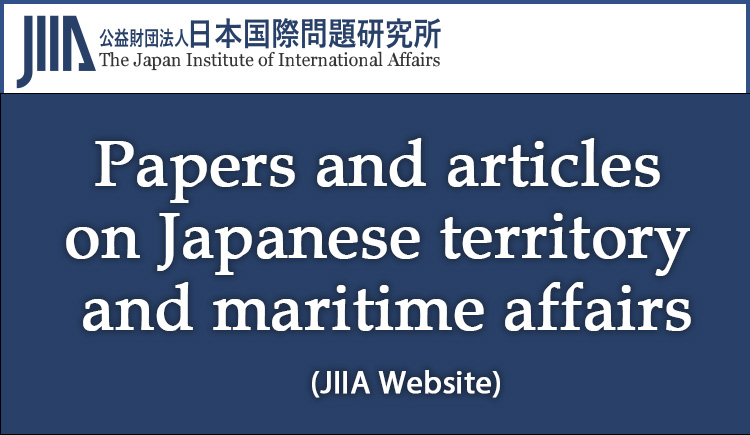The documents and materials published on this website were collected, researched, and prepared with advice from experts, as a part of a Government-commissioned project. The contents of this website do not reflect the views of the Government. Links to external sites (domains other than https://www.cas.go.jp) are not under the management of this site. For linked websites, please check with the organization/group that manages the website for the link in question.
Comprehensive issues
Column Factors Necessary for Acquisition of Title to Territory
Tetsuya Nakano (Professor, Faculty of Law, Kansai University)
*Adobe Acrobat Reader DC, provided by Adobe, is needed to view the PDF files. If you do not have the software, please download it from the linked site. Adobe Acrobat Reader DC
Judicial precedents of territorial disputes similar to the Takeshima issue
The Minquiers and Ecréhous case
It has long been pointed out that the case in which the United Kingdom and France put the attribution of the islets and rocks of the Minquiers and Ecréhous groups before the International Court of Justice has similarities to the Takeshima issue.
In either case, there is no treaty between the two parties that clearly stipulates the sovereignty over the disputed territory, and both parties assert that they have held the territories in question since a long time ago.
Minquiers and Ecréhous are two groups of small islands lying between the mainland of France and Jersey Island, which is a part of the Channel Islands under British rule. Since the end of the 19th century, the United Kingdom and France had both claimed sovereignty over these islands. But in December 1950, the two countries concluded a special agreement to refer this issue to the International Court of Justice.
The main point at issue was what ground, under international law, would adequately determine which country Minquiers and Ecréhous belonged to. First, both countries asserted that they held ancient or original title to the islands, based on historical facts dating from medieval times. With regard to this point, while the Court stated that in light of widely known historical facts, there appears to be a strong presumption in favour of this British claim of its “ancient title”, it held that this alone cannot draw definitive conclusion as to the sovereignty over the islands.
As for France’s claim of its “original title,” the Court found that, again, in light of widely known historical facts, even if France had held such a title, there is a strong possibility that the title must have lapsed, and consequently that there should be a need for it to be replaced by “another title valid.”
In the opinion of the Court, what is of decisive importance is not an indirect presumptions deduced from events in Middle Ages, but the evidence which relates directly to the “possession” of the islands.
The Court lists judicial records, taxation, land registration, enactment of relevant laws, and construction of facilities as evidence directly related to possession.
These indicate the intention to act à titre de souverain, and are regarded as a manifestation of State authority. Noting that the United Kingdom had presented more relevant proof, and that France had taken actions interpreted as recognizing that the disputed islands were British territory, the Court concluded that the sovereignty over the islands have belonged to the United Kingdom.
Standards presented by international tribunals
“Peaceful and continuous display of sovereignty”
State territory comprise land territory, the territorial waters, and air space. The fundamental element of the state territory is land territory.
As certain areas of the sea near land territory are regarded as the territorial waters and the air space over land territory and the territorial waters is regarded as air space, there would be no territorial waters or air space without land territory.
Sovereignty extends over state territory. Any state can govern and rule over all the people and things existing within its territory without being subordinate to other powers. Within its sovereignty, the rights that are related to the territory, such as the right to govern and the right to dispose of the territory, are known as territorial sovereignty.
In order to make a certain land a state’s territory, it is necessary to have a sufficient cause or ground to do so. This has been known as “title to territory” in international law. Occupation, prescription, cession, annexation, accretion, and conquest are the modes of territorial title that have traditionally been recognized. However, these territorial titles do not assume cases where several countries claim title to the territory at issue. In reality, conflicts arise as a result of competing claims made by plural countries to title to the territory in question such as Takeshima. Moreover, there is a considerable number of cases in which the complexity and diversity of the facts have led to conflict. For example, in cases where occupation is claimed, it is extremely difficult to find the facts that are necessary for determining whether the territory at issue had been terra nullius or belonged to another country, or else which country had exercised effective control over the territory.
Therefore, the international tribunals to which territorial disputes have been referred have resolved them by presenting their own set of standards instead of relying on the traditional criterion of title to territory. This began with the Island of Palmas case of 1928. Max Huber, who had been appointed as the sole arbitrator for this case, deemed the peaceful and continuous exercise of sovereignty to be equivalent to territorial title, and made the decision on the ownership of the Island of Palmas. Furthermore, the Permanent Court of International Justice ruled in the Eastern Greenland case of 1933 that the disputed territory belongs to Denmark, based on the ground of peaceful and continuous exercise of sovereignty by Denmark over the territory, and the acknowledgement of this by Norway, the other party in the dispute. In the abovementioned Minquiers and Ecréhous case, the International Court of Justice also ruled that the disputed territory belonged to the United Kingdom, which had intended to act à titre de souverain and presented more proof than France with regard to acts that are deemed to be expressions of state functions.
What are regarded as expressions of state functions and of the intention to act â titre de
souverain?
– The exercise of legislative, administrative, and judicial powers
Thus, international courts and tribunals have not resolved territorial disputes by finding one of the abovementioned traditional title to territory.
Rather, the courts and tribunals have adopted the method of requiring the parties to the disputes to present proof of peaceful and continuous exercise of sovereignty, that is, to show that they have effectively exercised or displayed state authority in the territory at issue, with the intention of act à titre de souverain. The courts and tribunals then made decisions based on the relative intensity of such proof presented.
Until now, the international courts has often regarded the exercise of legislative, administrative, and judicial rights in respect of the territory at issue as the peaceful and continuous exercise of sovereignty. Besides the acts that it found in the abovementioned Minquiers and Ecréhous case, other examples include the enactment of hunting and fishing laws (Eastern Greenland case), regulatory control measures on the harvesting of sea turtle eggs and the establishment of wildlife conservation areas (Sovereignty over Pulau Ligitan and Pulau Sipadan case), immigration control (visits by immigration officers to the territory at issue, issuance of work permits and visas to citizens of third countries: Maritime Delimitation in the Caribbean Sea case), and permission for civil servants of the country concerned to visit the territory at issue (Sovereignty over Pedra Branca and Pulau Batu Puteh case), among others.
On the other hand, opinion is divided over the construction or installation of facilities to aid navigation, such as lighthouses and buoys. In the case concerning to the Maritime Delimitation and Territorial Questions between Qatar and Bahrain, the state that constructed or established such facilities on the “very small island” was recognized as having sufficient grounds to assert sovereignty over the said island. But in the Minquiers and Ecréhous case, the relevant facilities were deemed to have been constructed or installed for the main purpose of protecting ship transportation, and not as a manifestation of state authority or the intention to act à titre de souverain. Acts such as joint patrols, exercises, or the raising of military flags, undertaken by the navies of several countries, are not usually regarded as manifestations of sovereignty inlight of their purposes (Sovereignty over Pedra Branca and Pulau Batu Puteh case).
As seen from the above, all the activities undertaken by any state organagencies are not necessarily regarded as evidence equivalent to title to territory.
We could say that International courts and tribunals determine the relative intensity of the evidence presented by the parties, taking account of various factors and especially the purposes of their activities.
As the activities of private individuals are, in principle, not attributed to the state, they are not regarded as a manifestation of state authority nor the intention to act as a sovereign. However, even activities by private individuals can be deemed as a manifestation of state authority or the intention to act à titre de souverain if they are carried out the basis of official regulations or on the permission of the government (Sovereignty over Pulau Ligitan and Pulau Sipadan and the case of Maritime Delimitation in the Caribbean Sea case). This is because such cases are deemed not to be purely private activities, but the exercise of the administrative power of the state via the activities of private individuals.
Consideration of the relevant factors
Even in cases where there have been no such acts as may be deemed to be a manifestation of state authority, the original title of the state that have ruled over the surrounding areas of the island in question can be acknowledged if the island is widely known as an obstacle that poses a risk to the navigation of ships, and if no competing claims have been put forward to sovereignty over that island Sovereignty over Pedra Branca and Pulau Batu Puteh case).
Maps attached to the treaty that stipulates the attribution of a territory, are treated as the evidence of the highest priority. Their value as evidence is otherwise dependent upon various factors, such as their source, quality, and the period of their production. Generally, an official map has higher value than a private map. Maps that present the territory at issue accurately and those produced before the conflict arose can also be evaluated highly.
What kind of effect the fact of the territory at issue being (or not being) carried in publications, especially government-sponsored books, can (or cannot) have, is one of the points at issue frequently raised in cases of territorial disputes before the international courts and tribunals. Courts and tribunals have taken various factors into consideration and assessed their effects. Partly due to space limitations in this article, suffice it to say that there is a judicial case that did not attach importance to whether accounts of the disputed territory are contained in government publications (Sovereignty over Pedra Branca and Pulau Batu Puteh case), as these publication stated facts only.

Takeshima
Research and Commentary Site
- I Comprehensive issues
- II Commentary on themes by historical period
- III Analysis of claims by other countries





